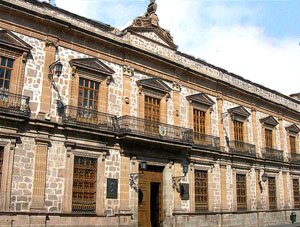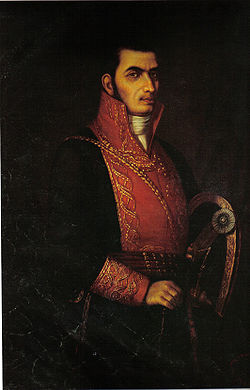 It was October, 1810. One of Valladolid's Roman Catholic priests was appalled. He had in his hand the proclaimation that he was supposed to read out to his congregation. It was the excommunication of Padre Hidalgo and a damning condemnation of the cause of the Army of the Americas, as issued by the Bishop of Michoacán, Manuel Abad y Queipo. Padre Morelos, sitting in his church, did not want to speak this to his parish. He didn't agree with it. It wasn't right!
It was October, 1810. One of Valladolid's Roman Catholic priests was appalled. He had in his hand the proclaimation that he was supposed to read out to his congregation. It was the excommunication of Padre Hidalgo and a damning condemnation of the cause of the Army of the Americas, as issued by the Bishop of Michoacán, Manuel Abad y Queipo. Padre Morelos, sitting in his church, did not want to speak this to his parish. He didn't agree with it. It wasn't right!Valladolid had been taken by the insurgents, on October 17th, but it hadn't been the carnage feared after reports from Guanajuato. The bishop had personally appealed to Hidalgo then and the settlement had been relatively peaceful. Now, as soon as Hidalgo had moved on, towards Mexico City, with his troops, the same bishop was issuing notices like this.
Padre Morelos had a lot of sympathy with the rhetoric coming from the ranks of the insurgents. They weren't just talking about Mexican independence, but they were highlighting the plight of the indigenious people in the fields. They wanted to abolish slavery and create a fairer society for all. Equal opportunities for all; universal education; a way to promote self-sufficiency for those who, through their race or caste, where slaves to the Spanish in all but name.
Padre Morelos might be registered as being of pure Spanish descent, but that had basically been his father, Manuel Morelos, playing the system, wanting him to get ahead. In reality, Morelos's mother, Juana María Guadalupe Pérez Pavón, had been a freed slave. She had both Indian and African blood. He should have more properly been registered as 'Mestizo' - mixed blood - especially once his father's mixed indigenious Mexico and Spanish ancestry was taken into account.

José María Morelos
However, that would have severely limited his work prospects. He would have become one of the very people that Hidalgo was fighting for. This wasn't to say that Padre Morelos hadn't done his share of hard, manual labour. He'd worked in the sugar-cane plantations for 11 years. But he was a intelligent man and that had been noticed. He'd been pulled out of the fields and into the offices, where he'd worked as a scribe and an accountant.
Morelos had earned enough money to fund his further education. At the age of twenty-five, he'd entered the Colegio de San Nicolás (San Nicolás's College), in Morelia. This was the oldest college in the Americas. It had been established in 1540 and it was very prestigious. He'd studied Latin grammar, rhetoric and moral philosophy, which had set him on the road to becoming a priest. But here was the rub. Morelos knew Padre Miguel Hidalgo. The man had been a rector at the same institution. He had been Morelos's lecturer and mentor. He had encouraged Morelos in his studies and his vocation.

Colegio de San Nicolás
That had been the early 1790s and Morelos had been on a great spiritual and educational journey since then. He'd completed further courses, in philosophy and moral theology, at Valladolid's Tridentine Seminary. Then, in April 1795, he'd taken the biggest leap of all. Morelos had travelled all of the way to Mexico City, to gain his BA degree, at Real y Pontificia Universidad de México (the Royal and Pontifical University). This was where Hidalgo had also studied, on his own path into the priesthood. Morelos had followed his mentor's advice in making a beeline for the place.
From there, it had been back to Michoacán state to the fast track into joining the clergy. First there was the city of Uruapan, in December 1796, where Morelos taught grammar and rhetoric, as an assistant priest. By September 1797, he was a deacon. In 1798, his dreams were realised and Morelos was ordained as a priest.

Now officially called Padre Morelos, he had moved around the state a lot. He had acted as parish priest in several villages, including Churumuco; Tamacuaro de la Aguacana, in La Huacana; San Agustín, in Carácuaro, and neighbouring Nocupétaro. In the latter, he'd personally overseen the building of a church. All of this with Hidalgo's early inspiration ringing in his ears, urging him to aim higher; be all that he was capable of being; rise above all that his background had decreed; be great.
Morelos looked to his idol as a role model in less secular ways too. Mexican Roman Catholic priests, then, as now, were expected to remain unmarried and celibate. Hidalgo had challenged that idea, asking where that prohibition had been mentioned in the scriptures?
Hidalgo had gone further than that, living openly with Maria Manuela Herrera and fathering her two daughters. Later, he'd met Josefa Quintana and he had three more children with her. Hidalgo had been examined by the Spanish Inquisition about it, but had been found innocent. Given that Hidalgo wasn't exactly concealing his role as common-law husband and father, it was a clear indication that the Church would turn a blind eye. Padre Morelos took note and followed the example of his mentor.
 As a parish priest, in San Agustín, Carácuaro, Padre Morelos had met Brigida Almonte. The couple didn't bother to hide their relationship. He'd even took her with him, when he crossed the river to take up the parish of Nocupétaro.
As a parish priest, in San Agustín, Carácuaro, Padre Morelos had met Brigida Almonte. The couple didn't bother to hide their relationship. He'd even took her with him, when he crossed the river to take up the parish of Nocupétaro. Their son, Juan Napomuenco Almonte, was born there in 1803. (In adulthood, he was to become president of Mexico.) However, the common-law marriage didn't last. Padre Morelos met another woman, in Nocupétaro, named María Ramona Galván. With her, he had a son, born in 1808; then a daughter, born in 1809.
With the Nocupétaro church built, Padre Morelos returned with his family across the river. It was back in his San Agustín Church that he now held the Bishop's proclaimation in his hand. Hidalgo, the man who had so pushed him and shaped his life; Hidalgo, whose fire and passion had inspired Morelos to reach further than he thought possible to achieve his dreams; Hidalgo, the man whose example had led to the joy of hearing his own small children playing in the yard; Hidalgo, who was even now raising an insurgency, in defence of the man whom Morelos, by rights, should have been. THAT Hidalgo? That was the man whom Morelos was supposed to condemn? And if he didn't speak out, would he lose his hard-won priesthood?
Padre Morelos had no choice. He had always followed Hidalgo. Now, perhaps, it was the most important occasion when he should. He put down the proclaimation. He saddled a horse and kissed goodbye to his family. Then he rode north-east. The Army of the Insurgents had not long left Valladolid, they couldn't be too far away. He followed the trail towards Mexico City, asking along the route, until he found them. The massive army had been about to march again. A few minutes more and he might have missed them at Charo.
Morelos pushed through to the front, until he glimpsed his idol. Hidalgo saw him and hailed him at once. The reunion was made in such high spirits that Morelos knew that he'd made the right decision. Hidalgo was full of praise for his young prodigy. As they rode towards Indaparapeo, the pair discussed the insurgency. By the time they booked into the village's Nazareth Inn, Morelos was being made a general (or a lieutenant, accounts differ). He was placed in charge of the southern part of the army. It was October 20th, 1810, and Morelos had just become a soldier.

Where to Visit:
* Morelia, Michoacán. This city is a UNESCO World Heritage Site. It is the birth-place of José María Teclo Morelos y Pavón; and it was renamed Morelia, from the original Valladolid, in his honor. The house in which Morelos was born is now Casa Natal de Morelos (Morelos's Birthplace Museum). It contains many documents signed by Morelos, plus some of his belongings.
A house belonging to Morelos in adulthood is now the Casa Museum José María Morelos y Pavón (José María Morelos y Pavón Museum). It contains many of his personal items and furnishings. To the west side of the city's cathedral is Morelos Plaza, which includes a statue of him.
Also check out the Plaza de Armas. This is where Mariano Matamoros was executed by firing squad, in 1814. Its alternative name is Plaza de los Mártires (Martyrs' Square) because of this and several other executions that took place during the War of Independence.
The Universidad Michoacana de San Nicolás de Hidalgo, in Morelia, is the original Colegio de San Nicolás. The 'de Hidalgo' addition to its name is in honour of Padre Miguel Hidalgo, who once lectured there as a rector. José María Morelos y Pavón was also there, as his student.
* Churumuco de Morelos, Churumuco, Michoacán. Originally this town was simply called Churumuco, but the 'de Morelos' was added in honor of José María Morelos. He once served as a parish priest here.
* Tamacuaro de la Aguacana, in La Huacana (town), La Huacana (municipality), Michoacán. Morelos was once the parish priest here.
* San Agustín, Carácuaro de Morelos, Michoacán. Originally this was a village called Carácuaro and it was where Morelos served as the parish priest.
Brigida Almonte, with whom Morelos had a son, lived here. It was renamed Villa de Morelos Carácuaro, in 1886, in his honor, but is more commonly called Carácuaro de Morelos. Casa Morelos, where he lived, is now a public library. In the town's central square, there is also a statue depicting Morelos.
On September 30th, every year, there is a festival held here to mark the anniversary of Morelos's birthday.
* Nocupétaro de Morelos, Michoacán. This town is just over the river from Carácuaro de Morelos, linked to it by a bridge. It was also a place where Morelos acted as parish priest and similiarly added 'de Morelos' to its name, in his honor.
Morelos and Brigida Almonte's son, Juan Napomuceno Almonte, was born here. He was later to become president of Mexico.
María Ramona Galván, the second of Morelos's lovers, lived here. He had two children with her, also born in the town.
* Charo, Michoacán. A stone bridge, near to the town, on the old Charo-Morelia highway, is traditionally viewed as the meeting point, where Morelos met Hidalgo. Inside the town, there's an eagle's head, which was recently placed as part of Route 2010 (one of the Bicentennial War of Independence national commemorations). For more information on these routes, visit their official site.
* Nazareth Inn, Indaparapeo, Michoacán. In October, 1810, this inn was where Hidalgo made Morelos a lieutenant in the Army of the Insurgents. It is still an inn today, where patrons may book a room for the night.
* Janitzio Island, in Lake Patzcuaro, Michoacan. There is a 39.6 meter (130ft) hollow statue of Morelos.


No comments:
Post a Comment